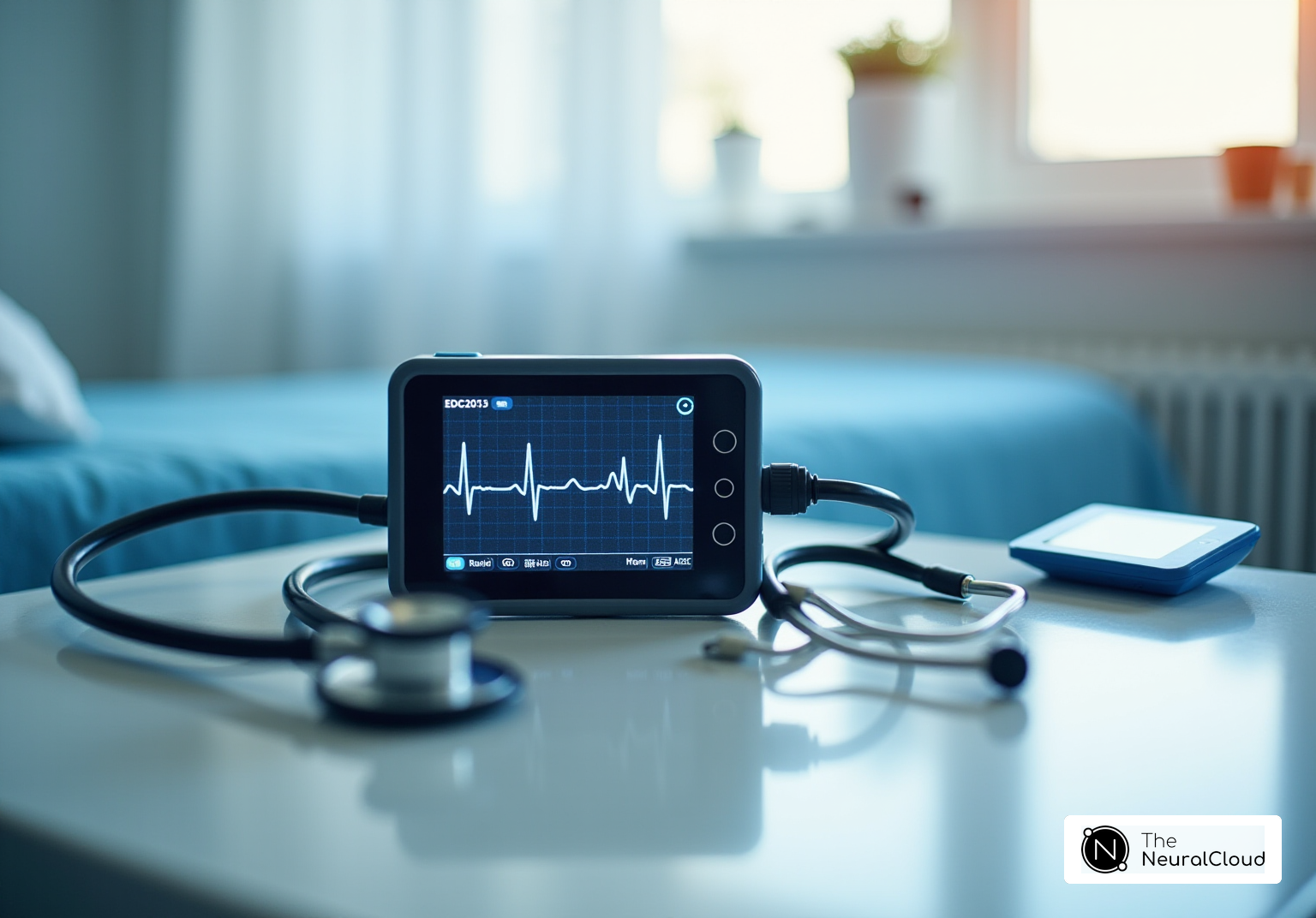Overview
This article provides essential tips for accurate ECG lead placement, emphasizing the significance of proper techniques and technology integration to enhance diagnostic accuracy. It begins by addressing the challenges faced in ECG analysis, such as artifacts and unclear readings. The article highlights meticulous skin preparation and correct electrode positioning as critical steps in the process. Furthermore, it introduces advanced platforms like Neural Cloud Solutions' MaxYield™, which significantly improve ECG analysis.
The MaxYield™ platform offers features that streamline the ECG lead placement process, ensuring optimal electrode positioning. By utilizing this technology, healthcare professionals can reduce artifacts, leading to clearer ECG readings. The advantages of employing MaxYield™ are substantial, as it not only enhances diagnostic accuracy but also contributes to better patient outcomes.
In conclusion, the integration of the MaxYield™ platform in ECG analysis represents a significant advancement in the field. Its ability to improve the clarity of readings and reduce errors ultimately benefits both healthcare professionals and patients alike. By adopting these techniques and technologies, practitioners can ensure more reliable and accurate ECG assessments.
Introduction
Healthcare professionals encounter a significant challenge in ensuring accurate ECG readings, as even minor misplacements can lead to substantial misdiagnoses. This article explores ten essential tips for achieving precise ECG lead placement, emphasizing the transformative impact of advanced technologies such as Neural Cloud Solutions' MaxYield™ platform.
As the medical field increasingly adopts AI-driven solutions, clinicians must consider effective strategies for integrating these innovations to enhance diagnostic accuracy and improve patient outcomes.
Neural Cloud Solutions: MaxYield™ for Enhanced ECG Lead Placement
Neural Cloud Solutions' platform is transforming the automation of through real-time feedback. This innovative approach allows healthcare professionals to achieve , which are essential for . By utilizing , the system assists clinicians in identifying the most effective lead positions tailored to individual patient anatomy. This enhancement not only boosts diagnostic accuracy but also streamlines workflows in clinical environments by utilizing an ECG lead.
The platform features sophisticated noise filtration and artifact management capabilities, enabling it to recover previously obscured segments of extensive . This addresses common challenges associated with the arrangements of manual ECG leads. MaxYield™ provides beat-by-beat analysis, delivering insights on P-wave, QRS complex, and T-wave onsets and offsets, which are crucial for recognizing cardiac events. Furthermore, the the platform's accuracy and efficiency over time.
As a result, the average turnaround time for ECG reports has been reduced to just 15 minutes, while Holter reports are generated within 2 hours, significantly . According to Peter Kendall, President and Chief Commercial Officer of AIML, "—delivering clearer ECG signals in noisy, real-world conditions." This statement emphasizes the platform's effectiveness in , ultimately contributing to better patient outcomes and more efficient healthcare delivery.
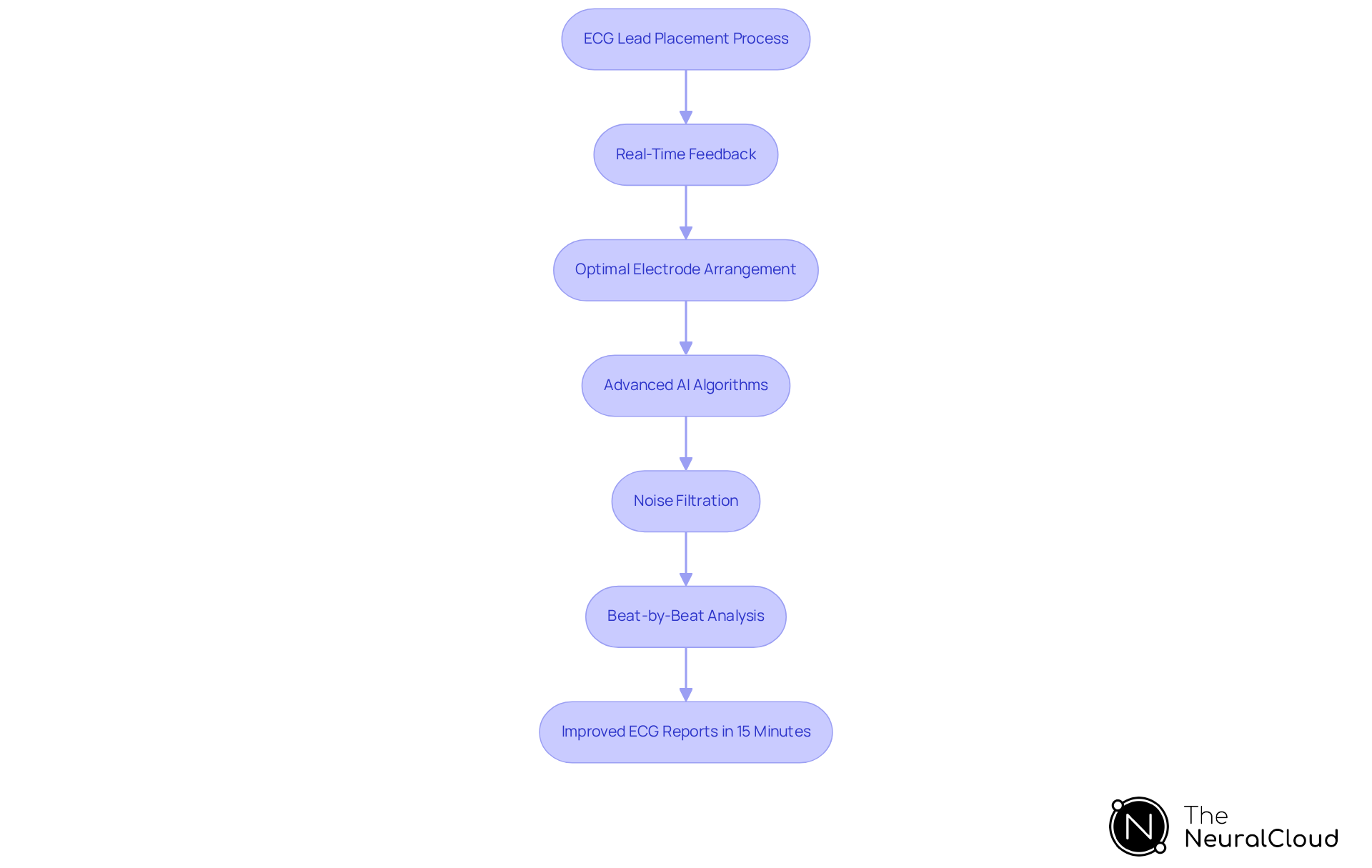
Ensure Proper Skin Preparation for Accurate ECG Readings
To obtain precise , is essential prior to the placement of the . This begins with cleaning the skin to eliminate oils, lotions, or dirt that may interfere with signal quality. Recommended methods include using abrasive pads or alcohol wipes, as these effectively reduce skin impedance, . Proper skin preparation minimizes noise, allowing the ECG lead to capture the heart's electrical activity with greater precision.
Despite optimal skin preparation, challenges such as can still affect the accuracy of ECG readings. This is where Neural Cloud Solutions' platform, MaxYield™, becomes invaluable. The system identifies and labels critical data, even in recordings with high noise levels and artifacts, rapidly isolating ECG waves from recordings impacted by baseline wander, movement, and muscle artifact.
By integrating MaxYield™ into the , can significantly enhance both efficiency and accuracy. This transformation in ECG testing not only but also streamlines the workflow for practitioners. Ultimately, the represents a critical advancement in the landscape of ECG lead analysis, enabling healthcare providers to deliver precise and reliable cardiac assessments.
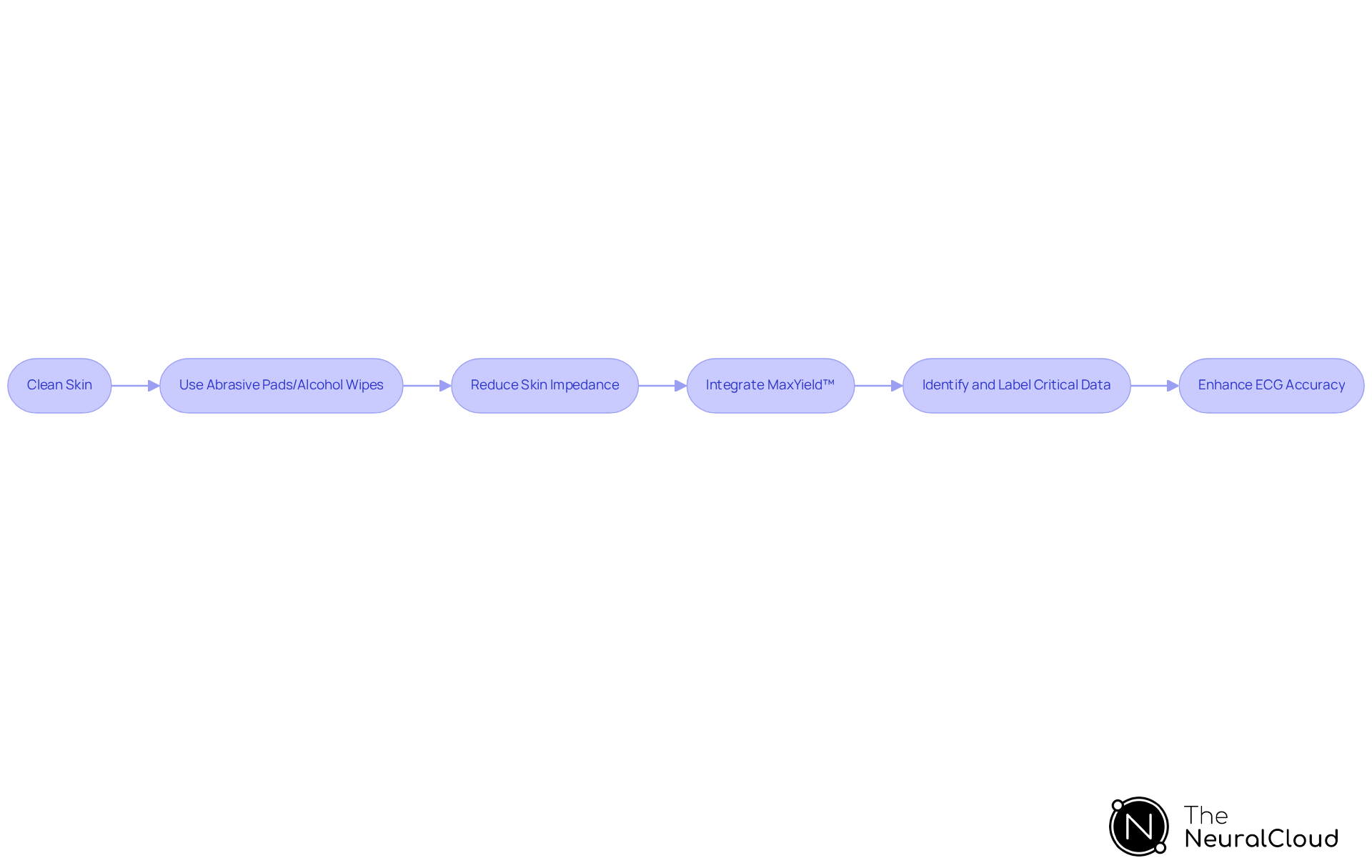
Position Limb Electrodes Correctly for Optimal Signal Capture
Limb sensors must be symmetrically placed on the patient's wrists and ankles to ensure precise readings from the . The right arm sensor should be positioned on the right wrist, while the left arm sensor is situated on the left wrist. Similarly, the right leg sensor is positioned on the right ankle, and the left leg sensor on the left ankle. The is crucial for capturing a clear representation of the heart's electrical activity.
Research shows that as much as 50 percent of healthcare professionals , which can result in misleading ECG patterns and possible misdiagnoses. Proper placement of the ECG lead not only enhances signal strength but also significantly reduces noise, thereby improving the overall accuracy of the ECG. The from Neural Cloud Solutions addresses these challenges by utilizing and distinct wave recognition capabilities. These features , even in challenging conditions with high levels of noise and artifact. As mentioned by Dr. Henry Marriott, 'Placement of the precordial sensor is often too casual, and for this reason, only bony landmarks should be utilized in identifying the precordial points.'
Following established guidelines for the is crucial for obtaining reliable results. The American Heart Association advises positioning the ECG lead sensors for the limbs distal to the shoulders and hips to reduce variability and guarantee uniformity across recordings. By adhering to these guidelines and integrating MaxYield™ technology, healthcare providers can and ultimately . Frequent training meetings centered on positioning can further emphasize the significance of .
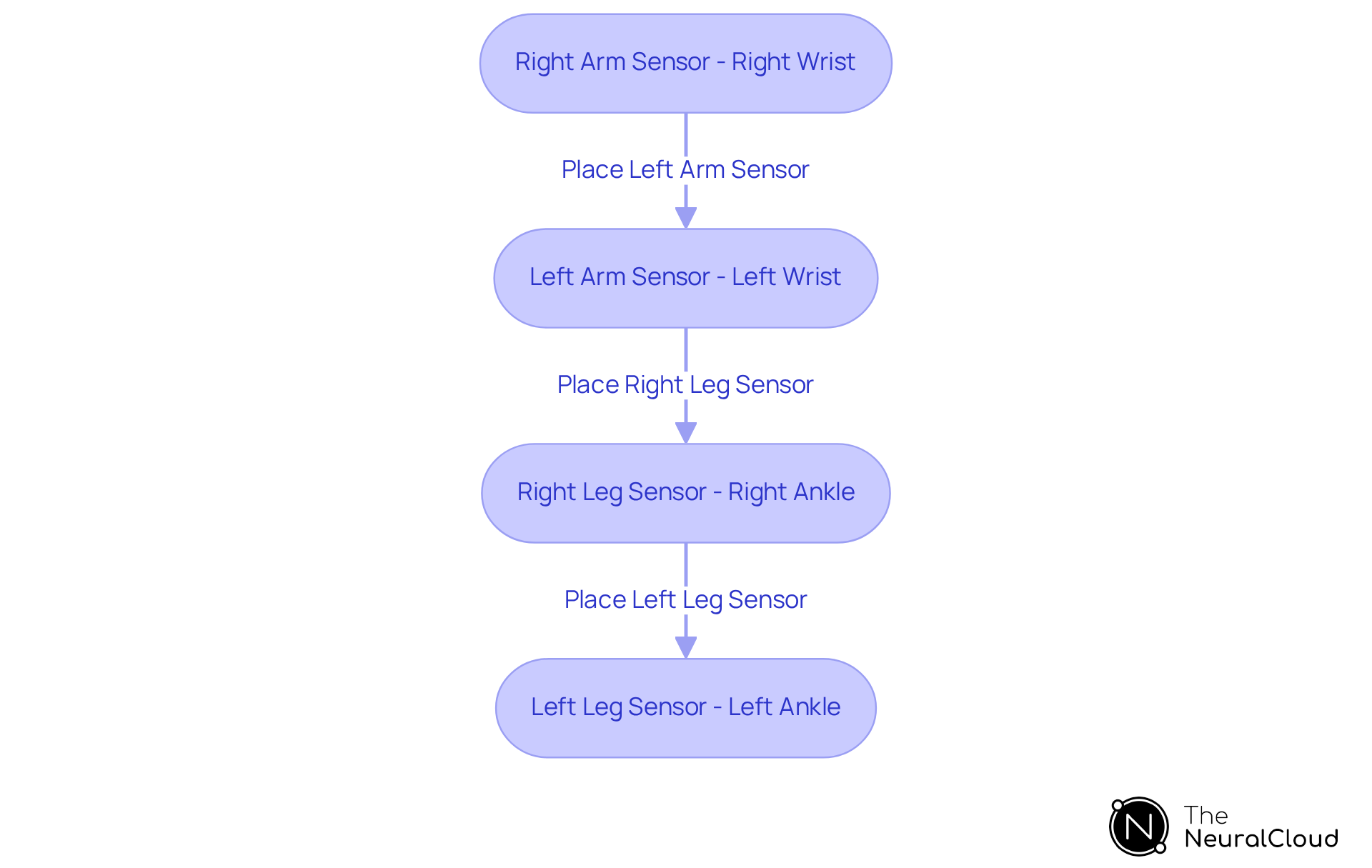
Accurately Place Chest Electrodes for Comprehensive Heart Monitoring
To ensure comprehensive heart monitoring, chest sensors must be positioned according to standardized locations (V1 to V6). For instance, V1 should be placed in the fourth intercostal space at the right sternal border, while V2 is positioned in the same space at the left sternal border. Correct positioning of the sensors is essential for , as it guarantees that the ECG accurately reflects the heart's electrical activity. Incorrect positioning can lead to significant misunderstandings, with research indicating that 41.6% of participants assessed their device positioning as 'acceptable.' Moreover, like V1 and V2 can result in inadequate R-wave progression, potentially mimicking conditions such as ventricular hypertrophy. Therefore, adherence to is crucial for and treatment planning.
With the integration of ' platform, healthcare professionals can significantly enhance the . and distinct wave recognition, enabling rapid isolation of ECG waves even in recordings affected by noise and artifacts. This but also adapts over time, addressing challenges such as . Ultimately, this evolution in ECG analysis revolutionizes the capabilities available to healthcare professionals, ensuring they can provide the best possible care.
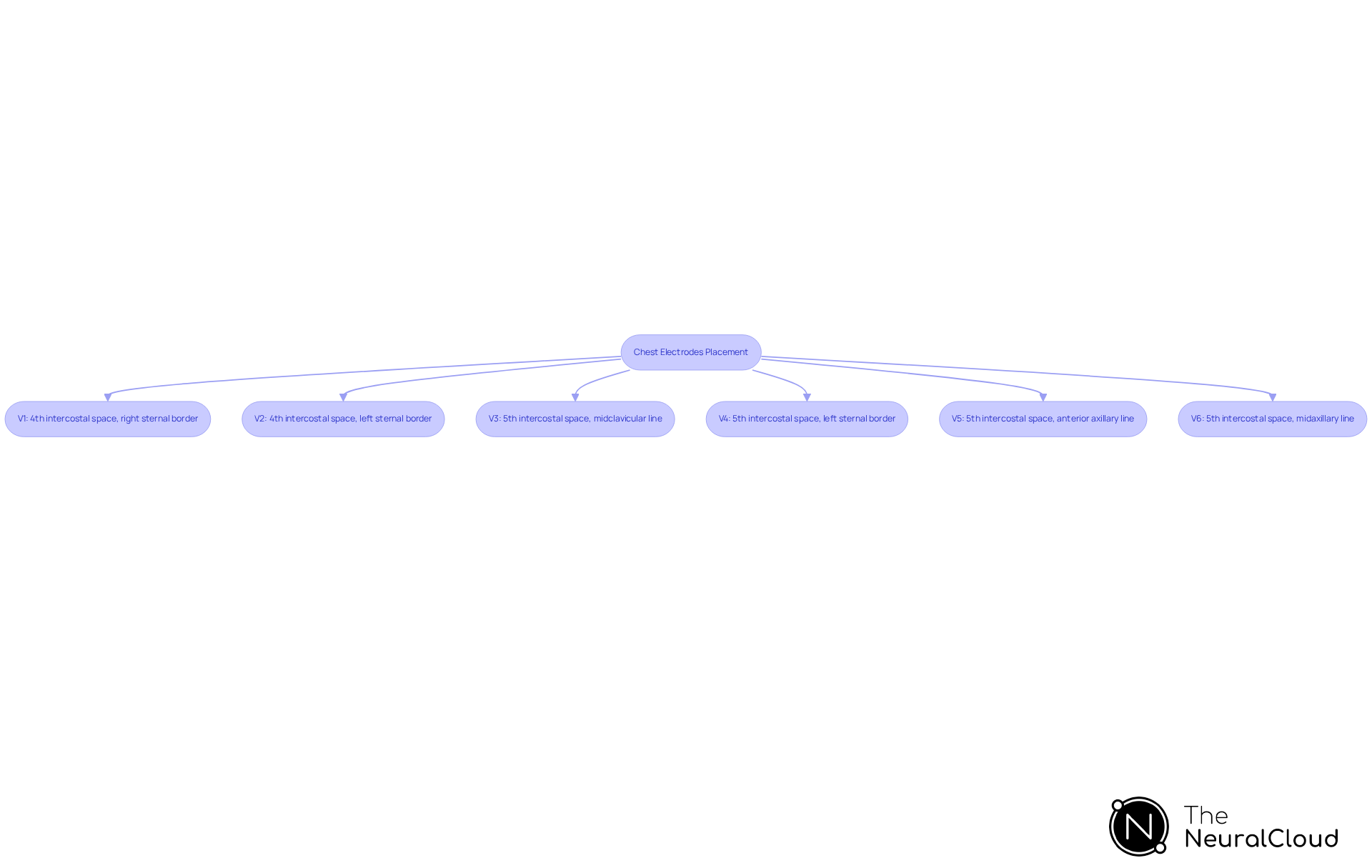
Adopt Standardized Color Coding for ECG Lead Placement
Applying a for the ECG leads—white for the right arm, black for the left arm, red for the left leg, and green for the right leg—greatly enhances the precision of . This systematic approach minimizes the risk of misplacement, which is crucial given that studies indicate a staggering 64% of nurses and less than 20% of cardiologists misplace leads. By adhering to these color codes, can ensure consistent positioning of the ECG lead, thereby improving the reliability of ECG readings.
Correct ECG lead positioning is essential for precise diagnoses and effective treatment plans, as incorrect positions can lead to and potentially harmful treatment decisions. Furthermore, the use of has been shown to reduce misplacement rates, ultimately contributing to better patient outcomes and safety in clinical settings.
Incorporating technology like into your workflow can further enhance these efforts. This platform automates ECG analysis, reduces noise, and provides detailed insights from each heartbeat, including the analysis of P-wave, QRS complex, and T-wave onsets and offsets. With MaxYield™, healthcare professionals can quickly assess 200,000 heartbeats in under 5 minutes, ensuring that even with , the data remains clear and actionable.
It is also important to consider the American Heart Association's recommendations regarding ECG lead positioning, as well as the need for to further enhance accuracy.
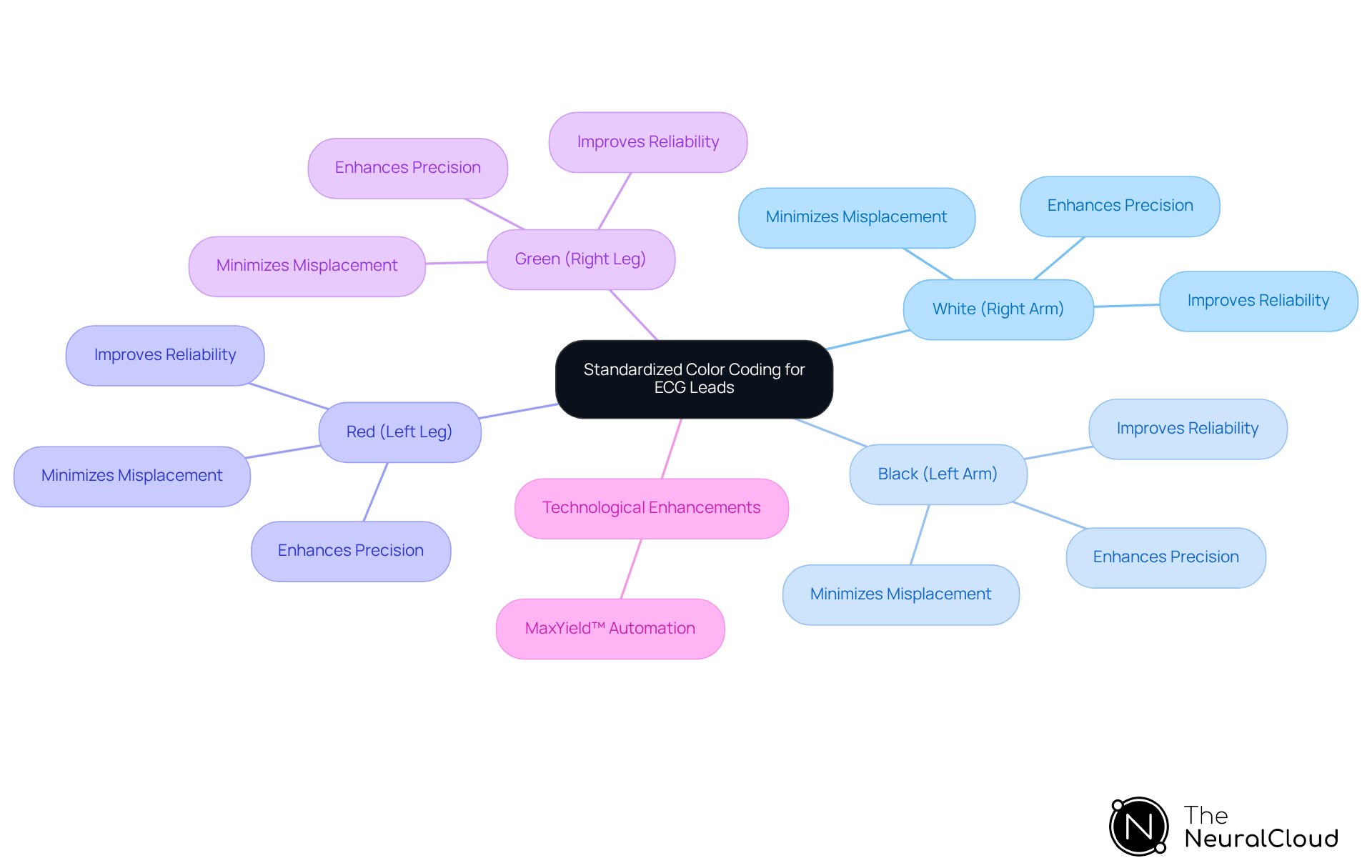
Identify Anatomical Landmarks for Precise Electrode Placement
To achieve accurate placement of the device, healthcare professionals must be well-versed in key , including:
- The clavicle
- The sternum
- Rib spaces
The fourth intercostal space serves as a vital reference point for positioning V1 and V2 sensors. A study revealed that only 5.8% of participants correctly positioned all chest sensors, highlighting the urgent need for . Proper positioning of the ECG lead V greatly improves the , since incorrect placement of the ECG lead can cause artifacts that undermine ECG signal quality. By mastering these anatomical references, clinicians can ensure that the ECG lead sensors are positioned correctly, ultimately leading to more reliable ECG readings and .
Furthermore, the integration of can significantly enhance this process. Its and aid in isolating ECG waves from recordings with noise. This technology supports clinicians in determining the best position for sensors by recovering previously concealed parts of extensive .
To reinforce this knowledge, healthcare professionals should engage in regular training sessions focused on anatomical landmarks and the application of like MaxYield™ to enhance their skills in ECG lead placement.
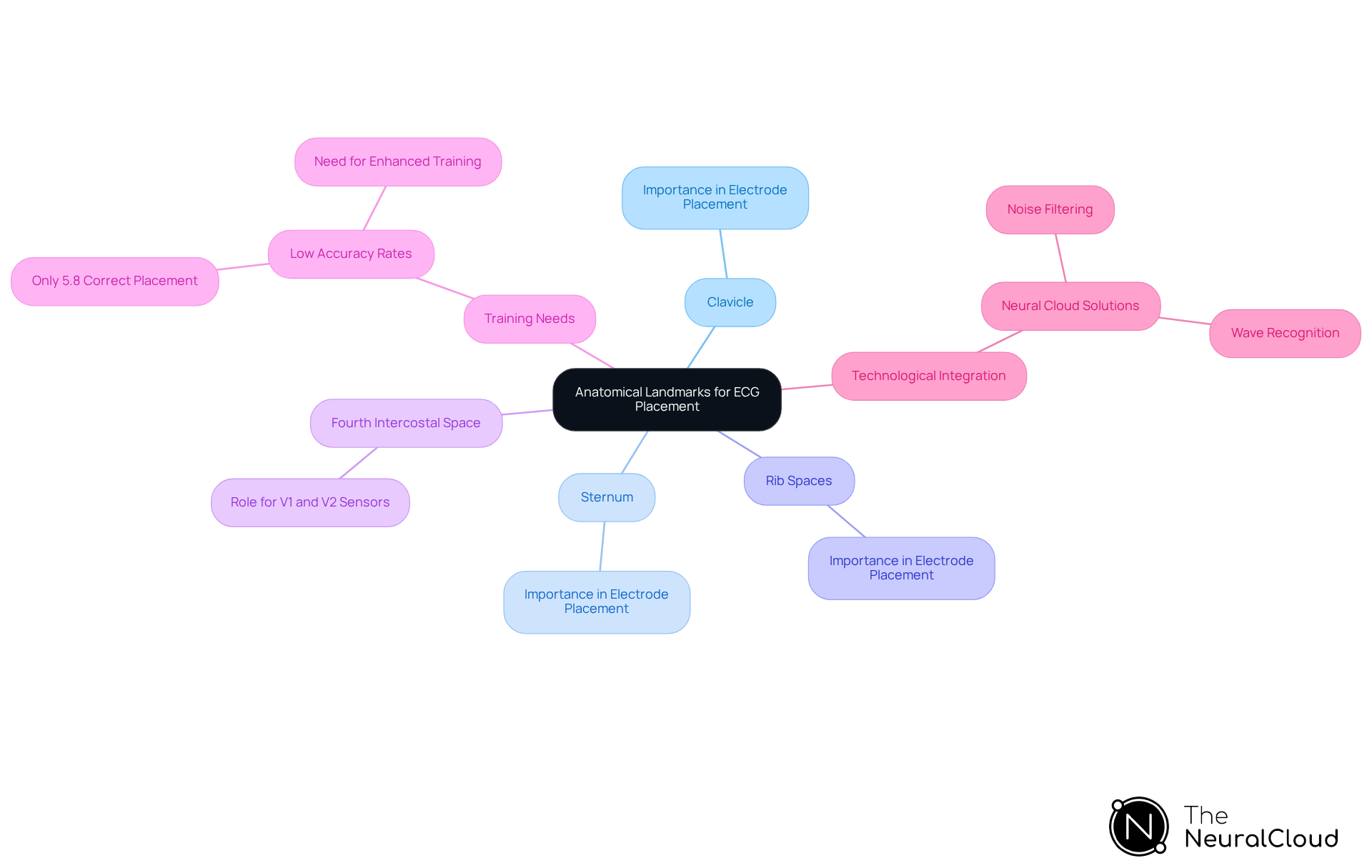
Minimize Artifacts to Enhance ECG Signal Clarity
To in the analysis of the ECG lead, it is essential to ensure that sensors are securely attached and that the skin is properly prepared. Furthermore, over areas with significant muscle movement or electrical interference, such as near pacemakers or defibrillators. By , healthcare professionals can , which is vital for of . This advanced technology features and wave recognition, enabling the recovery of previously obscured sections of recordings. The result is more accurate diagnoses, enhancing the overall .
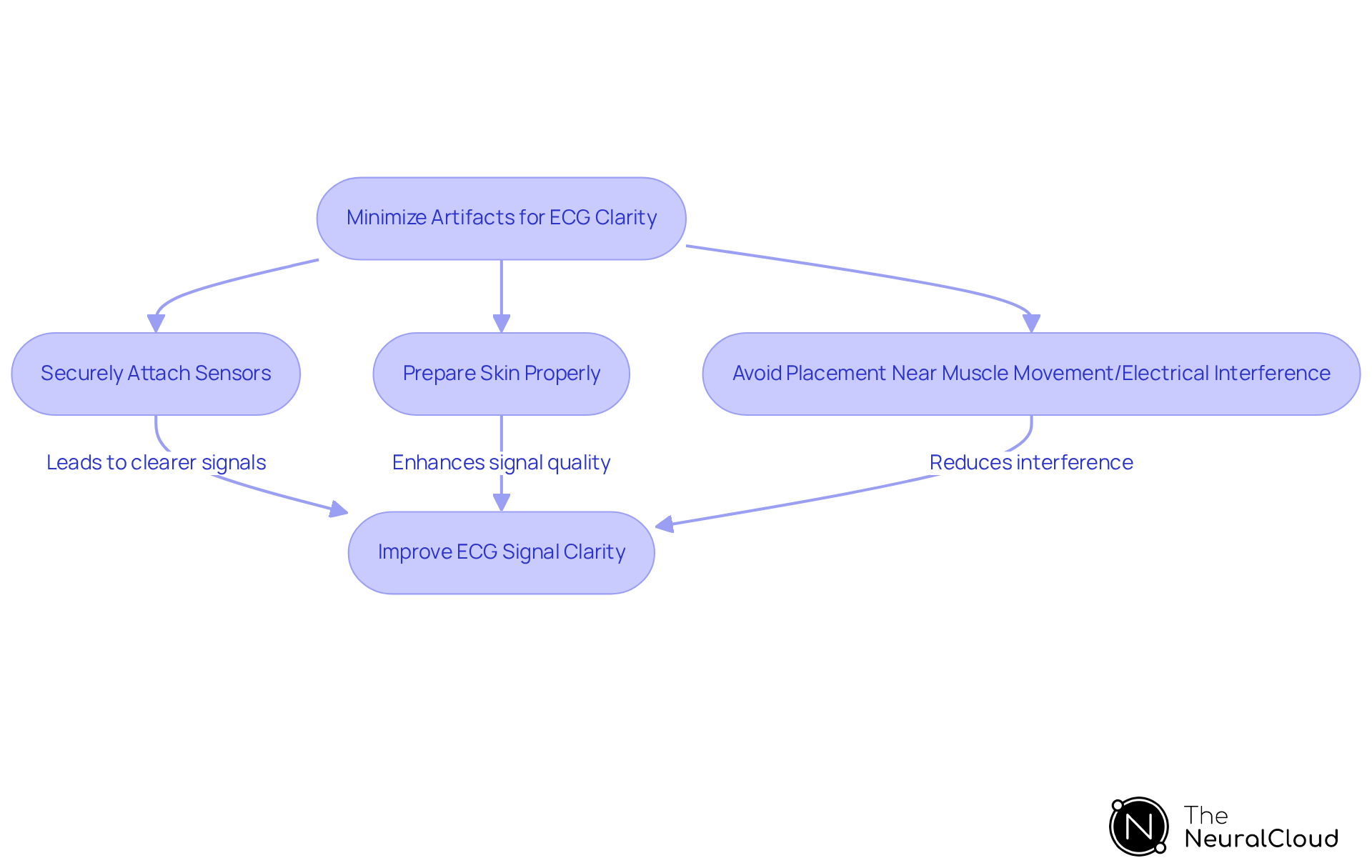
Educate Staff on Best Practices for ECG Lead Placement
Regular training sessions are essential for informing staff about the latest . These sessions should include:
- Practical workshops
- A review of revised protocols
to ensure that all team members are proficient in ECG lead positioning techniques. By incorporating the into these training sessions, staff can benefit from . This approach continuously enhances the . Ongoing education not only helps maintain high standards but also improves the overall quality of , effectively addressing challenges such as and signal artifacts.
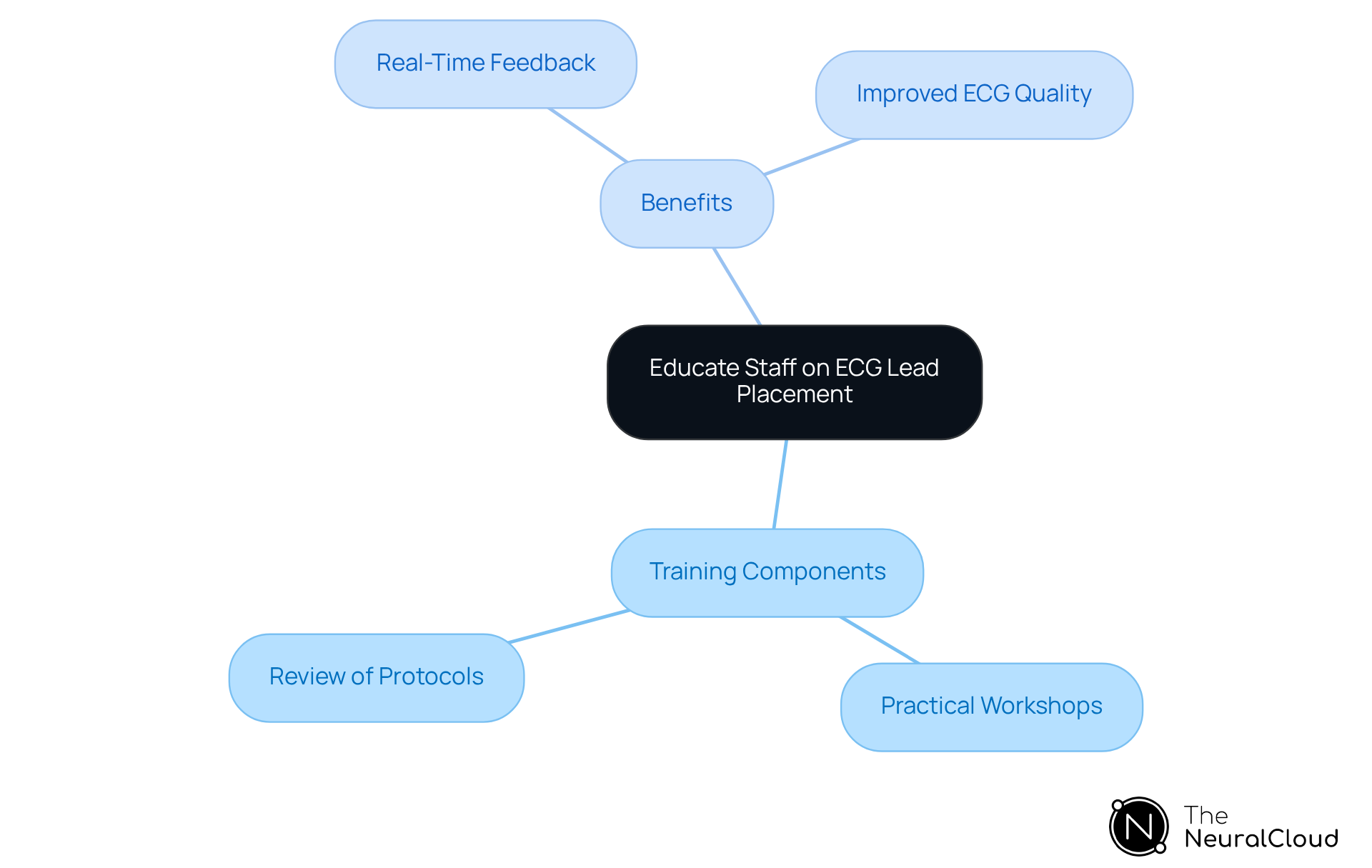
Review and Update ECG Protocols for Continuous Improvement
Healthcare facilities should establish a routine for reviewing and updating protocols related to the to incorporate the and best practices. This process involves evaluating the effectiveness of current techniques for ECG lead positioning and making necessary adjustments based on feedback and new research findings.
By leveraging Neural Cloud Solutions' technology, which automates the labeling of and employs advanced noise filtering, facilities can and enhance the .
Continuous improvement ensures that the ECG lead analysis remains accurate and reliable, effectively addressing challenges such as and .
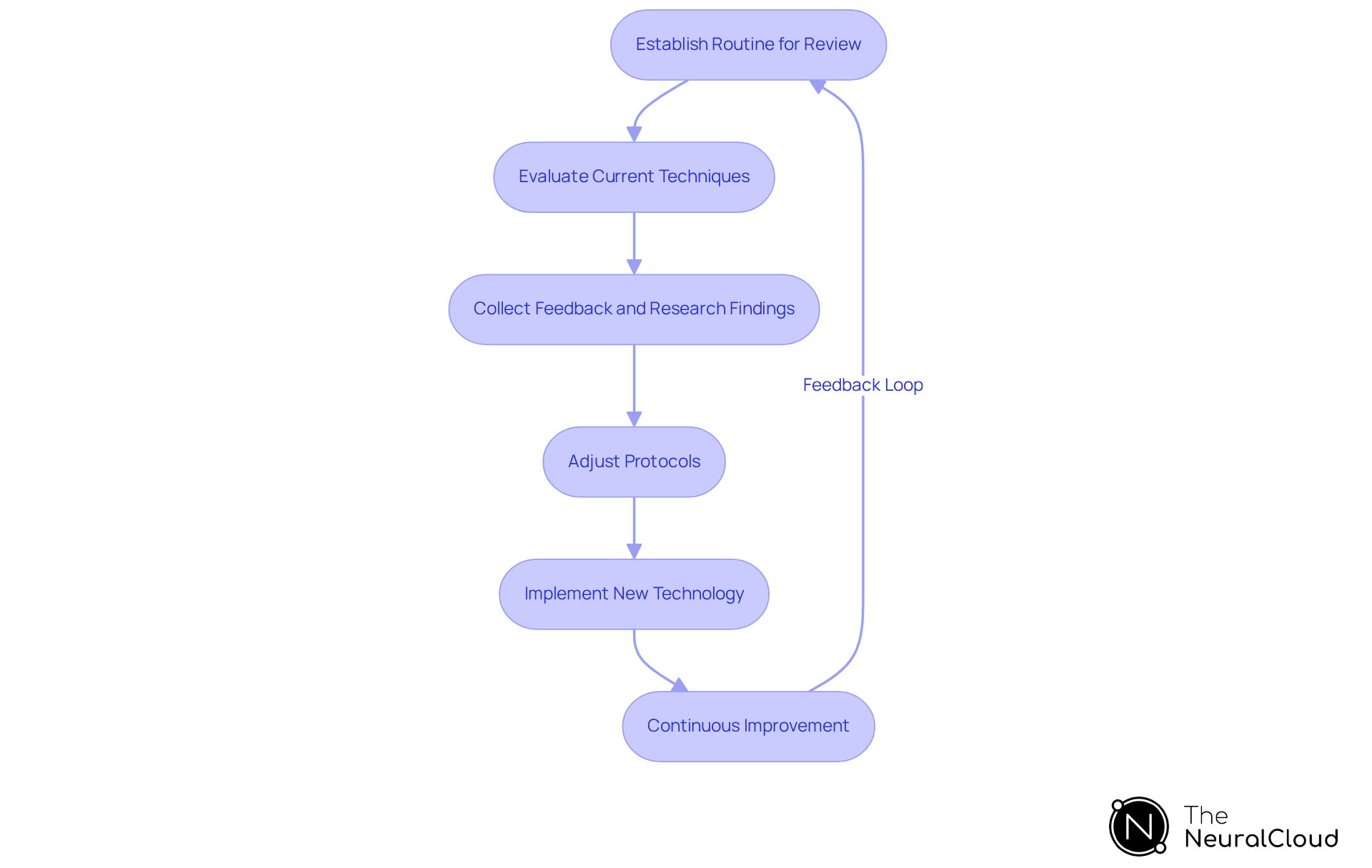
Leverage AI Technology for Streamlined ECG Lead Placement
The incorporation of AI technology, exemplified by ' innovative system, addresses the challenges in by providing . This system features and artifact management, ensuring that ECG signals remain clean and clear—an essential factor for accurate lead placement. The automated analysis capabilities of the platform facilitate swift processing of ECG data, delivering insights that tailored to individual anatomical characteristics.
The advantages of this approach extend beyond efficiency; they directly contribute to . Notably, studies have shown that , highlighting the potential of AI to refine ECG practices. However, it is crucial to acknowledge the , including the necessity for thorough validation and clinician training prior to integration into medical practice. Ensuring diverse training data is also vital for enhancing AI reliability and minimizing bias in healthcare applications.
By leveraging for optimal electrode positioning, healthcare professionals can streamline workflows, reduce misdiagnoses, and ultimately enhance the quality of cardiac care. The platform not only simplifies the ECG lead positioning process but also empowers clinicians with the tools needed to provide better patient care.

Conclusion
In summary, accurate ECG lead placement is vital for reliable cardiac assessments, and implementing best practices can significantly enhance diagnostic outcomes. Utilizing advanced technologies like Neural Cloud Solutions' MaxYield™ platform allows healthcare professionals to optimize lead positioning, reduce noise, and streamline workflows, ultimately leading to improved patient care.
Key strategies include:
- Proper skin preparation
- Correct positioning of limb and chest electrodes
- Standardized color coding to minimize errors
Ongoing staff education and regular protocol reviews are essential to ensure that medical teams are equipped with the latest techniques and advancements in ECG technology.
As the field of cardiac care evolves, embracing innovative solutions and prioritizing education will be crucial for healthcare providers. By committing to these practices, clinicians can enhance the accuracy of ECG readings, reduce misdiagnoses, and contribute to better patient outcomes. This solidifies the significance of accurate ECG lead placement in modern healthcare.
Frequently Asked Questions
What is MaxYield™ and how does it enhance ECG lead placement?
MaxYield™ is a platform developed by Neural Cloud Solutions that automates ECG lead positioning through real-time feedback. It utilizes advanced AI algorithms to help healthcare professionals achieve optimal electrode arrangements tailored to individual patient anatomy, improving diagnostic accuracy and streamlining workflows.
What features does MaxYield™ offer to improve ECG readings?
MaxYield™ includes sophisticated noise filtration and artifact management capabilities, allowing it to recover obscured segments of Holter and patch monitor recordings. It provides beat-by-beat analysis of critical cardiac waveforms, and its adaptive algorithm improves accuracy and efficiency over time.
How has MaxYield™ impacted the turnaround time for ECG reports?
The average turnaround time for ECG reports has been reduced to just 15 minutes, while Holter reports are generated within 2 hours, significantly enhancing workflow efficiency in clinical settings.
Why is proper skin preparation important for ECG readings?
Proper skin preparation is essential to eliminate oils, lotions, or dirt that can interfere with signal quality. Cleaning the skin reduces impedance and enhances the clarity of the ECG signal, minimizing noise and allowing for more precise readings.
What challenges can affect the accuracy of ECG readings despite proper skin preparation?
Challenges such as physiological variability and signal artifacts can still impact ECG accuracy. MaxYield™ helps address these issues by identifying and labeling critical data in recordings with high noise levels and artifacts.
How should limb electrodes be positioned for optimal ECG signal capture?
Limb electrodes must be symmetrically placed on the patient's wrists and ankles: the right arm sensor on the right wrist, the left arm sensor on the left wrist, the right leg sensor on the right ankle, and the left leg sensor on the left ankle.
What are the consequences of misplacing V1 and V2 sensors?
Misplacing V1 and V2 sensors can lead to misleading ECG patterns and possible misdiagnoses, as research indicates that up to 50 percent of healthcare professionals may incorrectly place these sensors.
How does MaxYield™ assist in the proper placement of ECG leads?
MaxYield™ enhances the clarity of ECG readings through advanced noise filtering and distinct wave recognition capabilities, which help improve signal strength and reduce noise, even in challenging conditions.
What guidelines does the American Heart Association provide for ECG lead placement?
The American Heart Association advises placing ECG lead sensors for the limbs distal to the shoulders and hips to reduce variability and ensure uniformity across recordings.


